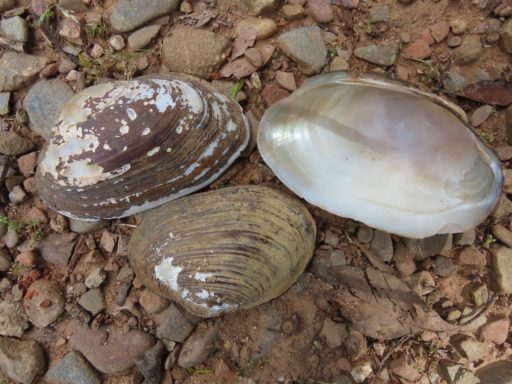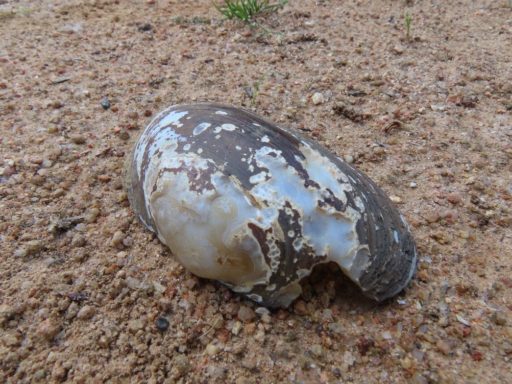LAKE HUME FRESH WATER MUSSELS

There are numerous species of native freshwater mussels in the Murray Darling Basin with Velesunio ambiguous being the most predominate. These bivalves once thrived in most slow flowing rivers, streams, backwaters, and the still waters of lagoons on the Upper Murray, Mitta Mitta and Kiewa River systems. Siltation of our streams through mining and erosion greatly reduced their numbers but in more recent times they have started to make a remarkable comeback.
To the untrained eye they are almost indistinguishable from their marine cousins. They were once easily obtained and were a major source of protein for local indigenous people. Aboriginal middens often contain the remains of this invertebrate to the exclusions of all others. Another and very important use of mussels was in the production of sharp blades. The lip of the shell could be worked to a razor-sharp edge by first grinding against a piece of slate or sandstone and then honing with a piece of smooth hardwood. These mussel blades could readily cut through flesh and sinew or carve intricate designs in wood. The half shells could also be used to prepare and hold precious materials such as ochre when dabbing onto the body.
In the local dialect, they were known as bucki, pucki, pucar and bucka. Bucka could also mean the shell alone. "Puckar-widgee" meant that mussels were to be got there (or alternatively a string of mussel shells), while "Buckan-ginga" (Henry & James Osbourne's station north west of Holbrook) meant the complete absence of that shellfish there. The suffix ginga meaning the negative. To highlight the peculiarities of the language over a relatively short distance Tarro-uringa-minga (House Creek, West Wodonga) also meant Mussel Creek.

The biggest predator of the fresh water mussel, apart from man, was the Australian Native Water Rat or Rakali. These aquatic rodents range in the waterways over much of Australia. The water rat attacks the bivalve by chewing through the hinge joining the upper and lower shell or by chewing directly through the shell itself.
To produce stone tools a suitable river cobble or piece of quarried stone was napped and flaked by striking it with a harder stone. For more delicate work such as producing stone points, burins or spear jags (barbs) a piece of stone (often glassy stone like chert, quartzite or flint was chosen) was usually pressure flaked by laying the workpiece on a stone anvil and pushing down hard with a tough substance like a wombat incisor. For much finer work a rat incisor was used. One wonders how such a fine tooth would be suitable for such tough work but when it is realised that the water rat's dentition was adapted or evolved to prey on the freshwater mussel it is understood that these teeth must be extremely hardy.

A fresh water mussel shell found on the shores of Lake Hume. The pearly white areas on the surface of the shell show where it has been gnawed and the open area at the end of the shell shows were the water rat has broken through to expose the fleshy contents.
